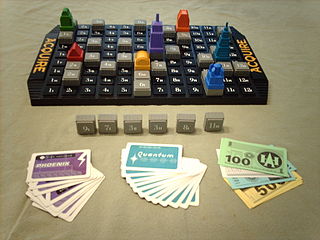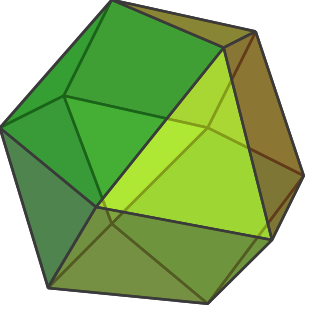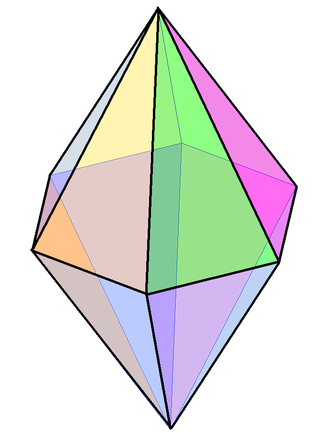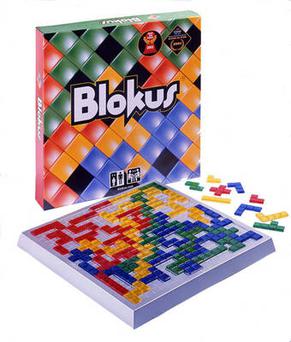
Acquire is a board game published by 3M in 1964 that involves multi-player mergers and acquisitions. It was one of the most popular games in the 3M Bookshelf games series published in the 1960s, and the only one still published in the United States.

A cuboctahedron is a polyhedron with 8 triangular faces and 6 square faces. A cuboctahedron has 12 identical vertices, with 2 triangles and 2 squares meeting at each, and 24 identical edges, each separating a triangle from a square. As such, it is a quasiregular polyhedron, i.e. an Archimedean solid that is not only vertex-transitive but also edge-transitive. It is radially equilateral.

In geometry, a hexagon is a six-sided polygon. The total of the internal angles of any simple (non-self-intersecting) hexagon is 720°.
A polyiamond is a polyform whose base form is an equilateral triangle. The word polyiamond is a back-formation from diamond, because this word is often used to describe the shape of a pair of equilateral triangles placed base to base, and the initial 'di-' looks like a Greek prefix meaning 'two-'. The name was suggested by recreational mathematics writer Thomas H. O'Beirne in New Scientist 1961 number 1, page 164.

Triominoes is a variant of dominoes using triangular tiles published in 1965. A popular version of this game is marketed as Tri-Ominos by the Pressman Toy Corp.

A wallpaper is a mathematical object covering a whole Euclidean plane by repeating a motif indefinitely, in manner that certain isometries keep the drawing unchanged. For each wallpaper there corresponds a group of congruent transformations, with function composition as the group operation. Thus, a wallpaper group is a mathematical classification of a two‑dimensional repetitive pattern, based on the symmetries in the pattern. Such patterns occur frequently in architecture and decorative art, especially in textiles, tessellations, tiles and physical wallpaper.

Escape from Atlantis is a board game that portrays the sinking of Atlantis and the attempts by the population to escape the sinking island. It was originally released in the United States under the title of Survive! and first published in the English language by Parker Brothers in 1982. The game was invented by Julian Courtland-Smith. Early copies of Escape from Atlantis include the name of the then co-copyright owner, C. Courtland-Smith.

A hexagonal bipyramid is a polyhedron formed from two hexagonal pyramids joined at their bases. The resulting solid has 12 triangular faces, 8 vertices and 18 edges. The 12 faces are identical isosceles triangles.

Blokus is an abstract strategy board game for two to four players, where players try to score points by occupying most of the board with pieces of their colour. The board is a square regular grid and the pieces are polyominoes. It was designed by French mathematician Bernard Tavitian and first released in 2000 by Sekkoïa, a French company. It has won several awards, including the Mensa Select award and the 2004 Teacher's Choice Award. In 2009, the game was sold to Mattel.
Skirrid is a board game designed for 2–6 players.
I'm the Boss! is a board game by American designer Sid Sackson. It is a negotiation game in which a group of players compete and cooperate to put together profitable business deals. The goal is to make the most money. I'm the Boss is currently published by Gryphon Games, after the Face2Face Games edition. It was previously published as Kohle, Kies & Knete.

The Eternity puzzle is a tiling puzzle created by Christopher Monckton and launched by the Ertl Company in June 1999. It was marketed as being practically unsolvable, with a £1 million prize on offer for whoever could solve it within four years. The prize was paid out in October 2000 for a winning solution arrived at by two mathematicians from Cambridge. A follow-up prize puzzle called Eternity II was launched in 2007.
Brax is a two-player abstract strategy board game. It was invented in 1889 in America by Frederic B. Denham of New York City. The board design is unique. The players move their pieces along paths on the square board; each path is one of two colors. A piece can move one or two spaces in a turn depending upon whether it matches the color of the path. Players attempt to capture each other's pieces.
Serpentiles is the name coined by Kurt N. Van Ness for the hexagonal tiles used in various edge-matching puzzle connection abstract strategy games, such as Psyche-Paths, Kaliko, and Tantrix. For each tile, one to three colors are used to draw paths linking the six sides together in various configurations. Each side is connected to another side by a specific path route and color. Gameplay generally proceeds so that players take turns laying down tiles. During each turn, a tile is laid adjacent to existing tiles so that colored paths are contiguous across tile edges.
Hexagony is an abstract strategy board game for 2 to 6 players that was published as Bin'Fa by Taoist Arts Inc. in 1977, as Hexagony by Avalon Hill in 1980, and later re-released in a slightly modified form by Kenterprises as Bin'Fa.

MacMahon Squares are an edge-matching puzzle first published by Percy MacMahon in 1921, using 24 unique squares with 3-color patterns; each of the four edges is assigned a single color. The complete set of 24 squares are organized next to each other by matching edge colors to create a 4 by 6 grid. Such tessellation puzzles have multiple variants, which are determined by restrictions on how to arrange the 24 squares. This game has also been commercialized in numerous physical forms, by various companies.
Tri-nim is a mathematical abstract strategy game developed by brothers Bruce L. Hicks and Hervey C. Hicks and published by WFF 'N PROOF Games from 1970 to 1975. Players move pieces around a triangular board, attempting to score points by being the last to enter each of the corners. It is a variation on the strategy game Nim.
Domain is a tile-based abstract strategy game first published throughout Europe in 1982. Players place multicoloured polymino tiles on a game board and flip any of their opponent's pieces adjacent to them in order to have the most squares covered by their colour at the end of the game.

Contack is a dominoes-like game for one to seven players which was patented by Parker Brothers and published in 1939. It uses 36 equilateral triangle tiles; each side is assigned a different color and numerical value. Players take turns laying tiles from a hand of five next to tiles already on the table; newly-laid tiles must match the color of adjacent tile(s).
Triangular Dominoes is a variant of dominoes using equilateral triangle tiles, patented by Franklin H. Richards in 1885. Two versions were made: a starter set of 35 unique tiles, with each side numbered from zero to four pips, and an advanced set of 56 unique tiles, with each side numbered from zero to five pips. In both versions, a wild card "boss" tile was included, making 36 and 57 tiles in each complete set, respectively.
































































































